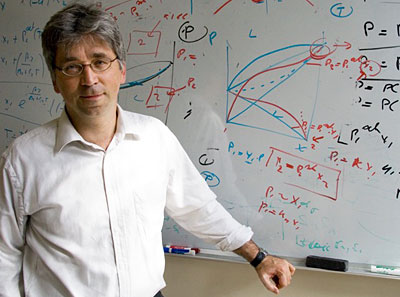
Berend Smit
Berend Smit, professor of chemical and biomolecular engineering
Berend Smit does critical work on carbon capture and sequestration, a field that’s vital to the nation’s efforts to slow climate change. He chooses to do that work at Berkeley.
When another university tried to lure him away last year, the offer proved worthy of serious consideration.
“The type of investment they wanted to make in this particular topic was impressive,” Smit says. The university offered him the ability to run a research group, as he does here, but without having to apply for research grants and work within their limits.
In the end, though, he said no.
“(When it comes to) chemistry and engineering, where I am at the moment are the best in United States,” Smit elaborates. “It will be very difficult to find a similar environment of colleagues and students. The support I could get was enough, but not in the context of it being a place where I could do comparable research.”
Smit’s research focuses on molecular simulations — what he jokingly calls doing fake chemistry on a computer. Some experiments, he explains, are too dangerous to conduct, or simply impossible. His work is to simulate those experiments on a computer, the way a flight simulator can test planes.
Computational chemistry, his specialty, also comes into play in calculating the properties of materials that have never been synthesized. That’s a key part of Smit’s work as director of Berkeley’s Energy Frontier Research Center, one of 46 such centers created by the U.S. Department of Energy at universities around the country to seek clean-energy solutions, including carbon capture.
Smit and his research group focus on identifying which materials would work best to keep carbon out of the atmosphere. When millions of materials might be possible but none of them has yet been synthesized, the question becomes: Which ones should be tried? Smit’s computations create possible materials and then calculate their properties. The process recently identified good prospects among a large class of porous materials possibly suited to soaking up carbon.
Once the materials are identified, scientists can try to make and test them in the lab.
This research was a big factor in Smit’s decision to stay at Berkeley. The carbon-capture and sequestration work had just gotten underway, and the EFRC was only two years into its five years of funding.
“Things are going quite well, and it’s not something I would like to stop,” he says.
Extra research funding through a chancellor’s chair played a role too. Federal funding can be restrictive, he says, and the extra funding helps cover unanticipated EFRC expenses, like a visiting researcher’s airfare on a non-domestic airline, or foreign travel, which federal grants exclude.
In the end, though, Berkeley was his choice for one reason more than any other: “The scientific and cultural environment is really superb.”